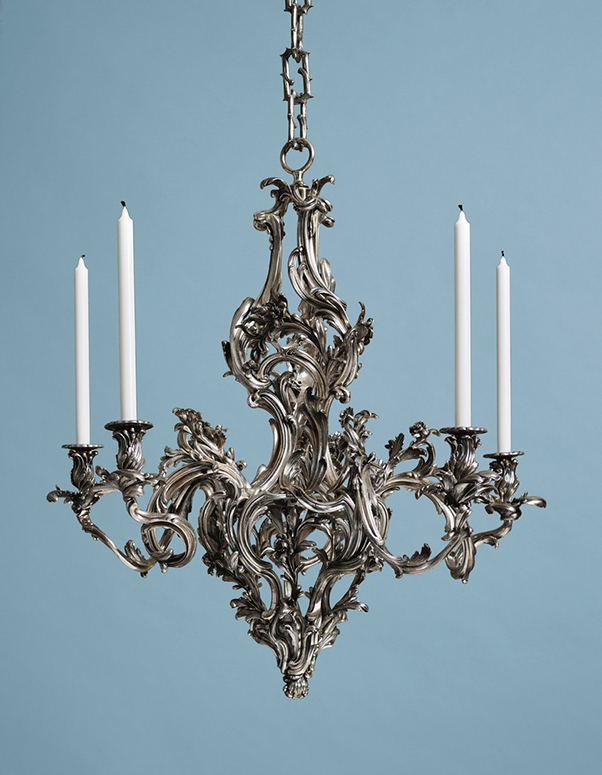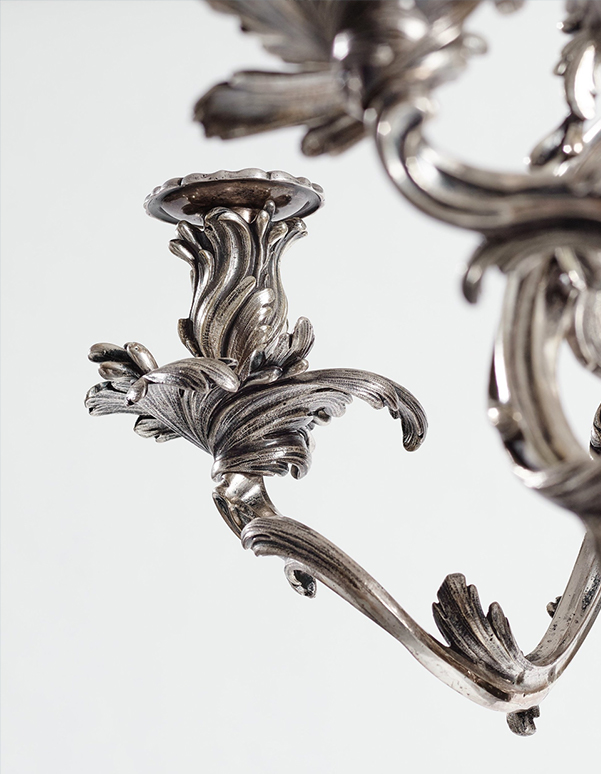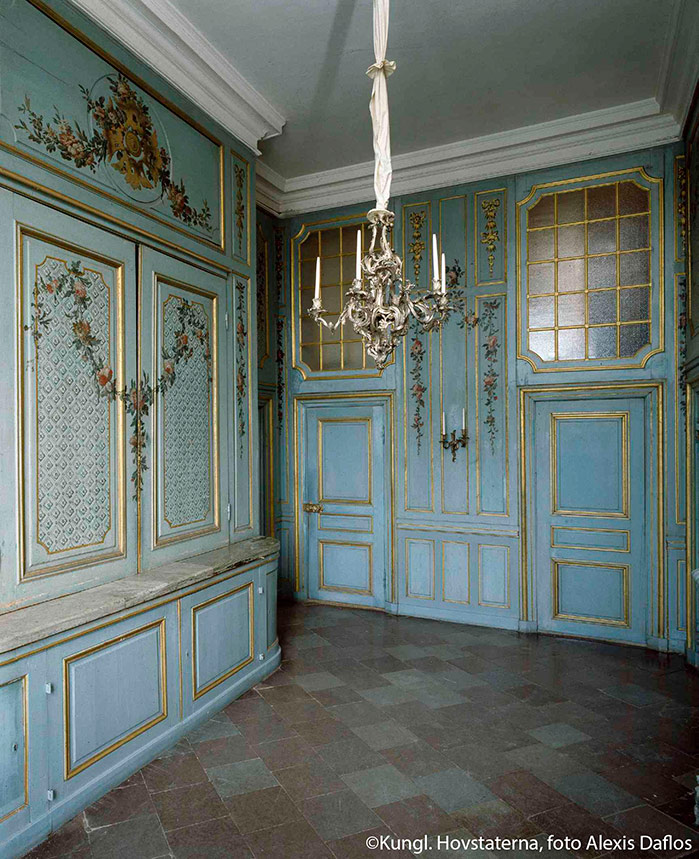A Rare Collector’s Item: Important Spring Sale presents a magnificent chandelier
A highly important & rare Louis XV silvered brass five-light chandelier attributed to Pierre Boulanger, Paris c 1750.
A Rare Collector’s Item
Rococo gilt bronze (brass) or silvered chandeliers are rare. Rarer still is the ability to identify their maker. The chandelier in the present sale, never before published, is just such a rarity.
The most famous examples are Jacques Caffiéri’s (1678-1755) gilt bronze chandeliers (both signed, one dated 1751), now in the Wallace Collection, London, and another pair also attributed to him in the Bibliothèque Mazarine, Paris, originally ordered for Madame de Pompadour. Lesser known is the silvered brass chandelier, executed by Boulanger, in the Swedish Royal Collections, today hanging at Drottningholm Palace.
The chandelier at Drottningholm
The chandelier on offer in the present auction should be considered a sibling to the one in the Royal Collections. The Drottningholm chandelier, HGK 261, has a well-documented history. Architect Carl Fredrik Adelcrantz purchased the chandelier in 1754 in Paris at the gilder and chaser Boulanger. His detailed invoice is still preserved in the palace archives. The chandelier, together with two pairs of silvered wall lights and a pair of chenets, were ordered when moving into the completed Royal Palace in Stockholm in 1754 and were placed in King Adolf Fredrik’s newly decorated Cabinet. In 1777 King Gustav III had the ensemble moved to ‘Blå garderoben’, an antechamber at Drottningholm, where the chandelier has been hanging ever since.
Sophisticated construction
It is fascinating that the chandelier in the present auction thus has an exact counterpart at Drottningholm Palace. A careful side-by-side examination of both chandeliers, done in connection with the cataloguing, revealed that they are practically identical in their design, measurements, décor and construction.

The chandeliers both have an open cage form, constructed from boldly undulating rocaille-decoration, leaves, and blossoms, and have five curved candle arms. In contrast to Caffiéri’s chandeliers, they have no interior iron body, instead, they are constructed from separately cast parts joined together like an intricate jigsaw puzzle around five larger rocaille-shaped sections. To achieve stability several parts have been joined together using intricate overlapping joints. To increase the stability even more the joints are reversed in relation to each other. Both chandeliers share this unique joinery and correspond in their measurements, as well as in their nuts and bolts made of iron. The chandelier’s visible body has a flat, polished interior, whilst certain sections that are not visible to the eye have been left rough and untreated. The hanging loop differs slightly, but in both chandeliers is ring-shaped.
Each candlearm has decorative branches of flowers attached with one individual screw at the base. On the Drottningholm chandelier, there are additional holes with which to position the tip of the branches, something that the chandelier in the present auction is missing – one of the very few differences between the objects.
That different makers could have produced these chandeliers should be ruled out. Assembled, as they are, like large jigsaw puzzles of numerous, loose and cast parts, some slight differences are to be expected, and it seems highly improbable that two separate makers could have achieved such similitude.
Argent haché – silver-plated brass
Whilst the term ‘argent haché’, when speaking of silver-plated objects, has today vanished from use in France, Boulanger’s invoice attests to its usage in the 18th century. However, the expression caught on in Sweden and came to signify both a method of silvering on brass and a general term for silvered objects. In order to prevent confusion with real silver, in 1762 it became a requirement in Sweden that “so-called Argent Haché or plated with Silver Brass-Works” were stamped. Very recent research has also shown that the term was used in Holland, which underlines how argent haché was once part of a widely used, established terminology.
The question of base metal is interesting. The denomination ‘gilt (or silvered) bronze’ has over time become the standard term internationally, even though it is actually brass, not bronze. During the 18th century, the terms brass and bronze were used in parallel – although the latter seems to have dominated within certain trades. In both cases, it consists of yellow copper alloys, where the copper has alloyed with either zinc or pewter. Copper was the central and expensive part. In France, a tax had been introduced between March 1745 and February 1749 on all alloys with copper and objects made from it should be stamped with a crested C (‘C’ – couronne).


The Getty Museum has analysed all the ‘bronzes’ (fittings, sconces etc.) in their collections of objects from the Baroque and the Regence periods and has found that the base metal in all of these examples was, strictly speaking, brass. That the invoice from 1754 states ‘bronze’ is therefore not surprising even if in reality it silvered brass.
”du dernière Goût”
The chandelier that Adelcrantz purchased in 1754 was to hang in King Adolf Fredrik’s cabinet. This was a highly prestigious and distinguished room, and its interiors should therefore be of the highest fashion.
Boulanger’s invoice stipulates that the chandelier has been created in the latest taste, “du dernière Goût” [sic], and this is clear to see. The chandeliers are classic examples of the rococo aesthetic. Their scattered, latticed, and asymmetrical form, concealing the construction, gives them a lightness and creates a continuous movement accentuated by the décor and the uneven number of candle arms. If you compare the chandeliers with the above-mentioned examples by Caffiéri, the latter’s construction appears more old-fashioned with a more pronounced central body, according to the Baroque style, even if the design is flowing with the typical rococo rocaille-decoration and tendrils.
No direct model or design has been found for the chandelier in the auction or for the one at Drottningholm Palace, but its execution is reminiscent of the work of the perhaps most influential designer of the period, Juste-Aurèle Meissonnier (1695-1750). His bold design language and playful movement characterise the chandeliers’ compositions.
It wasn’t just the design that was of the latest fashion – silvering had enjoyed a short period of popularity within French interior design around 1750. In Germany, the style had had more sway and the German-born Swedish royal couple, therefore, came to appreciate it.
The wear on the silver surface – from keeping it polished – resulted in many of the objects instead soon being regilded. Larger, preserved objects are therefore very few and rare to find. We can now add to the list of these unusual objects the present silvered chandelier, identical to the one at Drottningholm Palace.

Boulanger, a family of gilders and chasers
Boulanger (also Boulangé) was a family of gilders and chasers. Their workshop was situated on Rue de la Verriere, by the sign reading ‘Au Saint-Esprit’. The invoice from 1754 is signed ‘father [“Père”] Boulanger’ – by which means Pierre. His business card gives a clear overview of the business: “makers and retailers of all kinds of objects, both gilded and in argent haché, such as fire garnitures, centrepieces… lanterns…”
The workmanship involved in the objects bought in 1754, as well as in the chandelier in the present auction, attests to the high quality of their manufacturing. The workshop was later taken over by the son, Louis-Barthélemy. When he passed away his widow remarried, to be ‘conserved’ as per tradition, with the gilder Nicolas-Joseph Aimé, who in this way succeeded as master gilder-chaser in 1783. That the workshop was of the highest standard is exemplified in Aimé’s collaborations with the very best bronze casters and gilders of the Louis XVI style, such as Pierre Gouthière and Francois Rémond.
When is the viewing and auction?
Viewing 27 May – 1 June, Berzelii Park 1, Stockholm.
Auction 2 – 4 June, Arsenalsgatan 2, Stockholm.
For more information Contact specialist

Stockholm
Björn Extergren
Head of Consignment and Sales Department, Fine Art. Specialist Antique Furniture, Decorative Arts and Asian Ceramics
+46 (0)706 40 28 61

Stockholm
Carl Barkman
Head Specialist Fine Art and Antiques
+46 (0)708 92 19 71






















